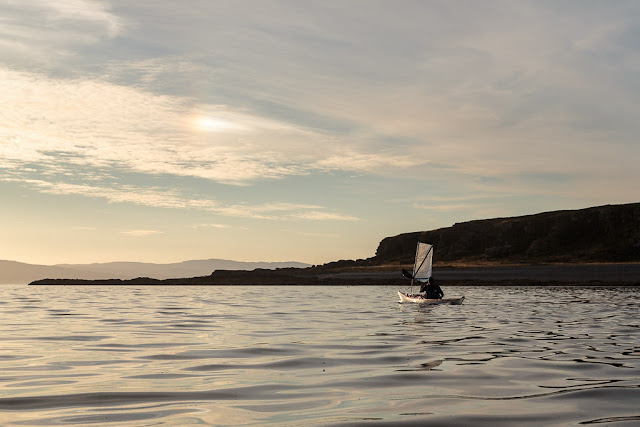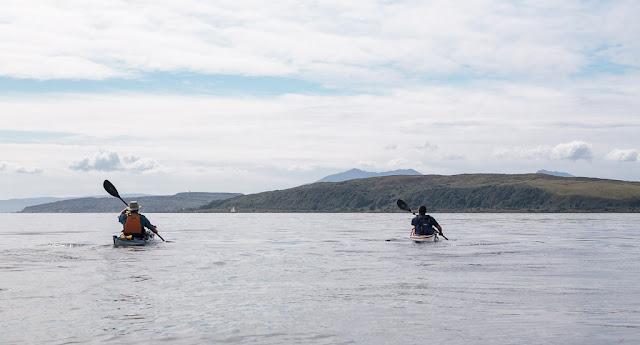After a comfortable night's camp we rose before dawn to find clouds of midges swarming round the tent vents. Once down on the beach a gentle NW wind was just enough to keep the worst of the midges at bay.
We quickly brewed some warming tea and...
...porridge but despite it being the height of the Scottish "summer" it was bitterly cold.
Fortunately as the sun rose so did the temperature and our spirits.
The wind also began to rise as we carried our kaks through the narrow gap in the reef to the sea. As our eyes turned up the Sound of Bute to the NW....
...it looked like the forecast F4 wind might shortly arrive and it would be going our way. It was time for some paddle sailing!
Imagine you are at the edge of the sea on a day when it is difficult to say where the land ends and the sea begins and where the sea ends and the sky begins. Sea kayaking lets you explore these and your own boundaries and broadens your horizons. Sea kayaking is the new mountaineering.
Thursday, September 17, 2015
Friday, August 28, 2015
Fire at sunset by the Sound of Bute.
Once we had got the kayaks up above where we expected high water to be we unloaded our bags just as...
...the sun was setting.
A few midges came out as we were putting the tents up but fortunately the breeze increased just enough to stop them flying.
There was no sign of the fire Mike and I had made back in June and we set a new fire in the same place. It was nice having the heat of the fire while preparing our evening meal.
It was not just the fire that was glowing. Long after sunset the sky was too!
We decided that our new Helinox chairs were a fabulous addition to any camp fire!
Once the fire was well lit and...
...there were plenty embers we put the tatties in to bake.
...the sun was setting.
A few midges came out as we were putting the tents up but fortunately the breeze increased just enough to stop them flying.
There was no sign of the fire Mike and I had made back in June and we set a new fire in the same place. It was nice having the heat of the fire while preparing our evening meal.
It was not just the fire that was glowing. Long after sunset the sky was too!
We decided that our new Helinox chairs were a fabulous addition to any camp fire!
Once the fire was well lit and...
...there were plenty embers we put the tatties in to bake.
We enjoyed our perfect baked potatoes in the twilight. The only sign of human activity was the Holy Island outer light and lights from a couple of fishing boats plying the Sound of Bute. All this, companionable conversation and no midges, we were certainly in heaven!
Wednesday, August 26, 2015
An atmospheric crossing to Inchmarnock with a sighting of a fire rainbow.
At 6pm we landed for a second luncheon on a little shingle bay to the north of Garroch Head. We had paddled to this point in shorts and tee shirts. We put our salopettes on, not because it was cold (it wasn't) but because we knew we would arrive at our destination on Inchmarnock about sunset and that is when the midges come out!
As we restored energy levels with a snack and a hot drink we enjoyed the most spectacular view across to Glen Sannox on Arran.
Back on the water we had an 11km crossing to our destination of Inchmarnock. We passed Dunagoil Hill which is topped by an Iron Age hill fort.
As we crossed Scalpsie Bay clouds began to gather but the horizon to the west was clear, promising a fine sunset.
A little breeze got up as we passed...
...the fertile fields of Scalpsie farm on Bute which contrasted...
...with the rocky granite ridges of the Arran mountains on the other side of the Sound of Bute.
The sun was lowering towards the horizon as we...
...approached the south end of Inchmarnock. High in the sky we spotted cloud iridescence...
...which is not a commonly seen atmospheric effect. This is also known as a "fire rainbow" or a "rainbow cloud," It usually occurs in late afternoon on hot humid days.
The west coast of Bute is not easy to land on as at low tide there are a series of rocky reefs. It was near spring low water but we knew of a tiny gap in the reefs (about 8m wide). We arrived just after 8pm. This gully can be very difficult to launch from if there is any west in the wind. There are easier beaches at the south and north of the island. Although we had feared a midge attack we were pleasantly surprised that a little NW breeze stopped them flying.
As we restored energy levels with a snack and a hot drink we enjoyed the most spectacular view across to Glen Sannox on Arran.
Back on the water we had an 11km crossing to our destination of Inchmarnock. We passed Dunagoil Hill which is topped by an Iron Age hill fort.
As we crossed Scalpsie Bay clouds began to gather but the horizon to the west was clear, promising a fine sunset.
A little breeze got up as we passed...
...the fertile fields of Scalpsie farm on Bute which contrasted...
...with the rocky granite ridges of the Arran mountains on the other side of the Sound of Bute.
The sun was lowering towards the horizon as we...
...approached the south end of Inchmarnock. High in the sky we spotted cloud iridescence...
...which is not a commonly seen atmospheric effect. This is also known as a "fire rainbow" or a "rainbow cloud," It usually occurs in late afternoon on hot humid days.
The west coast of Bute is not easy to land on as at low tide there are a series of rocky reefs. It was near spring low water but we knew of a tiny gap in the reefs (about 8m wide). We arrived just after 8pm. This gully can be very difficult to launch from if there is any west in the wind. There are easier beaches at the south and north of the island. Although we had feared a midge attack we were pleasantly surprised that a little NW breeze stopped them flying.
Tuesday, August 25, 2015
En route to Bute with Simian Rock and squadrons of shearwaters.
We set off from the Little Cumbrae castle on what seemed like the first hot sultry afternoon of summer.
The Arran mountains always delight and the sight of them rising...
...above the reefs of Gull Point is always worth a photo.
Little Cumbrae is composed of layers of lava flows from successive eruptions.
Ian spotted this mimetolith high on the cliffs...Simian Rock.
It was a spring tide so before crossing to Garroch Head across the south going ebb tide...
...we took a north going eddy to just before the lighthouse. This saves a lot of energy maintaining a high ferry...
...angle on the crossing. We enjoyed seeing porpoises and diving gannets but...
...the real treat on the crossing was seeing squadrons of shearwaters skimming the sea round us.
We were welcomed to Garroch Head by a very large grey seal.
The Arran mountains always delight and the sight of them rising...
...above the reefs of Gull Point is always worth a photo.
Little Cumbrae is composed of layers of lava flows from successive eruptions.
Ian spotted this mimetolith high on the cliffs...Simian Rock.
It was a spring tide so before crossing to Garroch Head across the south going ebb tide...
...we took a north going eddy to just before the lighthouse. This saves a lot of energy maintaining a high ferry...
...angle on the crossing. We enjoyed seeing porpoises and diving gannets but...
...the real treat on the crossing was seeing squadrons of shearwaters skimming the sea round us.
We were welcomed to Garroch Head by a very large grey seal.
Sunday, August 23, 2015
Rare doldrums in the Firth of Clyde.
It has been a particularly windy and mostly wet summer here...
...on the west coast of Scotland.
...fun in a whole variety of...
...conditions and in a variety of...
...craft even including a return to...
...windsurfing after a gap of 6.5 years due to my dislocating knees.
I am not interested in sea kayak camping in such weather though so it was with great pleasure that Ian, Mike and I saw a brief weather window open on Monday and Tuesday last week.
So we met at Largs at 1300 hours and spent a little time fitting Ian's new Flat Earth Trade Wind 80 sail to his kayak.
We set off for Little Cumbrae island in a flat calm.
We met the beautifully restored wooden gaff rigged cutter Islay. She was built in 1936 by Cooper of Conyer in Kent. Her construction is of teak on oak so she should be around for many more years. She certainly was not going any where fast and her sails were shaking with the gentle motion of the boat.
We set off across the Tan unsure whether to pass the north or south of the Little Cumbrae island.
In the end a little NW breeze got up so we paddle sailed across...
...from the Ayrshire coast towards the south of the island passing several porpoises on the way.
Passing the Little Cumbrae castle, it was too good an opportunity to miss a...
...stop for first luncheon.


















































